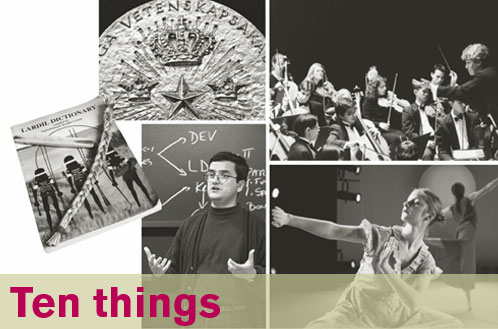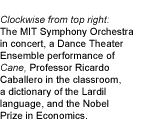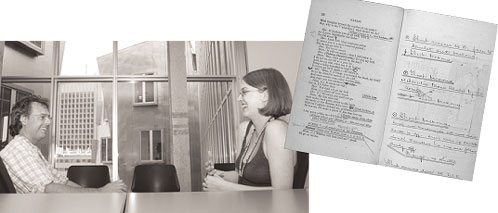
   
| 1 |
Percentage of MIT students (yearly average) enrolling in arts courses: 50 |
MIT has always been an institution known for its stellar science and technology education and research. But one of the hallmarks of the great scientific work done at MIT has always been its creativity. MIT attracts students with incredible depth, who are looking for creative outlets. And more often than not, this applies to the arts as well as the sciences. Between 60 and 70 percent of incoming MIT freshmen, on average, bring with them experiences and interests in the arts. And this interest creates an environment in which creativity is celebrated daily—on stage, in the practice room and studio, and in classrooms and corridors all over the Institute.
| 2 |
Number of Nobel prize winners among current and former members of the MIT Economics Department in the past 5 years: 5
Number of John Bates Clark Medal winners in the past dozen years who are current or former members of the MIT Economics Department: 5
(awarded bi-annually to the economist under 40 who has made the most important contribution to economics) |
Nobel prize winners 2003: Robert Engle, shared Economics, MIT Professor of Economics 1969–1977; 2001: George A. Akerlof, shared Economics, MIT PhD 1966, Joseph E. Stiglitz, shared Economics, MIT PhD 1966; 2000: Daniel McFadden, shared Economics, MIT Professor of Economics 1978–1991; 1999: Robert A. Mundell, Economics, MIT PhD 1956
John Bates Clark Medal winners 2003: Steve Levitt, MIT PhD 1994; 2001: Matthew Rabin, MIT PhD 1989; 1999: Andrei Shleifer, MIT PhD 1986; 1993: Lawrence Summers, MIT BS 1975, Professor of Economics 1979–1982; 1991: Paul Krugman, MIT PhD 1977, Professor of Economics 1979–2000
Ever since MIT's third president, Francis Amasa Walker, introduced undergraduate studies in economics more than a century ago, the Economics Department in SHASS has been nurturing great minds. As
the list above attests, both faculty and graduate students in the department are standouts. In addition to Nobel and Clark winners, the faculty of the Economics Department boasts MacArthur Fellows, Fellows of the National Academy of Sciences and the American Academy of Arts and Sciences, and past presidents of the American Economic Association. And here's another number that stands out when describing the Department of Economics . . . the last time (2001) US News and World Report ranked graduate economics programs, MIT came out number one.
| 3 |
Undergraduate courses typically offered by STS each semester: 22
Number of these typically offered jointly with other departments: 12 |
The numbers don't lie; the STS Program is the most collaborative program in MIT . . . not to mention in SHASS!
The program, which is beginning its 28th year this fall, has as its core mission understanding the intersection—and integration—of science, technology, and society. The program's structure reflects this mission; 6 of the 13 STS faculty members hold joint appointments, and more than half of the program's courses are listed jointly with other departments, including brain and cognitive science, electrical engineering and computer science, anthropology, history, linguistics and philosophy, media arts and sciences, physics, political science, women's studies, and writing and humanistic studies. More undergraduate courses along these lines are being planned, including joint ventures with aeronautics and astronautics, medicine and biotechnology, and others.
The PhD program in the History and Social Study of Science and Technology (HSSST) also embodies the interdisciplinary model and is offered collaboratively by STS, History, and Anthropology. More than two thirds of the students who take HSSST graduate courses are not enrolled in the HSSST program. HSSST courses typically attract students from Comparative Media Studies, the Science Writing Program, the Engineering Systems Division, the Media Lab, the Department of Urban Studies and Planning, the Department of Architecture, the Health Sciences and Technology Program, and others. The range of interests and strengths creates a vital and versatile program that offers crucial new perspectives on major developments in our rapidly changing world.
Below, left to right: Professor Steve Yablo and grad student Heather Logue chat in the new home of the Philosophy Program in MIT's Stata Center, and a Hamlet promptbook from the Shakespeare Electronic Archive. (Courtesy of the University of Pennsylvania, the Furness Shakespeare Library, and the Schoenberg Center for Electronic Text & Image.)

| 4 |
First Boston Symphony Orchestra concert: 1881
First MIT Symphony Orchestra concert: 1884 |
The MIT Symphony Orchestra (MITSO) has been around for a while; but it is by no means unique. The wide range of performing ensembles at MIT allows students of all levels of ability, from beginner to virtuoso, to find their niches. Groups are led by professional musicians on the teaching staff, and include the symphony orchestra, chamber orchestra, chorus, chamber chorus, wind ensemble, jazz band, jazz ensemble, chamber music, Boston's only Balinese Gamelan ensemble, and a Senegalese drumming group . . . to name just a few. With these ensembles, as well as with classes in composition, music history, and music theory, more than 1,500 MIT students participate in SHASS's music program every year.
Another standout fact? The faculty. Among the professors who lead these ensembles and teach these classes, SHASS boasts a recent president of the Handel Society, a Pulitzer Prize-winning composer, the founder and leader of Bang on A Can All Stars, current and former soloists with many of the world's leading orchestras, the director of the Rockport Chamber Music Festival, and a leading researcher and performer of film music. And this is only the "music" half of the Music and Theater Arts Section!
| 5 |
Rank of MIT's philosophy program among all PhD granting departments in the country: 8th
(tied with 3 other departments)
Size of MIT's philosophy program among the top 50 PhD programs in the country: smallest |
Ending the 2003–04 school year with ten and a half full-time faculty members, the Philosophy Program at MIT is the smallest of the departments in the top ten. Among the top seven departments nationwide, the average number of full time faculty is 23.6—more than twice the size of the SHASS entry. Yet MIT consistently earns a place among the top ten, and is acclaimed for its great strength in the core areas of philosophy (metaphysics, and philosophy of the mind, language, logic, math, and science).
The department also continues to receive high marks among its students for the intimacy and rigor of its program. In fact, enrollment in undergraduate subjects is up 44 percent over the last 8 years. The addition of two new faculty members this fall will enable the department to meet this growing demand. Rae Langton and Richard Holton (see profiles in the New Faculty section) bring strengths in philosophy of language and law, metaphysics, moral psychology, history of philosophy, and feminist philosophy. The two (who are married) also continue an interesting trend within the department; as of this fall, 40 percent of the faculty in the department will be married to other department members! (And certain sources within the department tell us this number could rise . . . .)
| 6 |
Number of threatened languages currently being studied and restored in SHASS: 6 |
MIT's number one ranked Linguistics Program focuses on most of the traditional areas of linguistics—phonology, morphology, syntax, semantics, and psycholinguistics—as well as questions concerning the interrelations between linguistics and other disciplines. In addition, faculty members and graduate students in the department often do extensive work with endangered languages, working both to document and revive these languages, as well as to find out what these languages have to teach us about the structure of human languages in general. Current language projects in the Linguistics Program involve:
Wampanoag—Algonquian, once spoken in Eastern Massachusetts;
Mohegan—Algonquian, once spoken in Connecticut;
Lardil—an Aboriginal language of the Tangkic family, of northern Australia;
Buli—a Gur language of northern Ghana;
Mebengokre—a Je language spoken in the Brazilian rainforest; and
Tlingit—a Native American language, possibly related to the Athabaskan family, of Alaska and British Columbia.
The program hopes to continue its commitment to endangered languages with a new Master's program in linguistics for speakers of threatened languages. Graduates of the program will be able to use their linguistic knowledge to help their communities keep their languages alive. In addition, the MIT Indigenous Language Initiative will offer expanded opportunities for MIT students and faculty to become involved in indigenous and endangered languages, through work with native speaker linguists in the SM program and also with outside groups.
| 7 |
Number of students who have participated in international internships sponsored by MISTI since 1994: 1,300 |
MIT International Science and Technology Initiatives (MISTI) internships, run under the auspices of SHASS's Center for International Studies (now in its 53rd year), are open to both MIT undergraduate and graduate students. Typically, the experience begins with an on-campus immersion into the host country's culture, followed by an intensive professional internship in the country lasting from
8 weeks to a year. Students work in internships in their own area of technical expertise, gaining knowledge of their own specialty along with an understanding of a foreign culture and work environment.
Currently, MISTI has programs in China, France, Germany, India, Italy, Japan, and Singapore. A pilot program in Mexico began in the summer of 2004. In addition to student internships, MISTI fosters international collaborations and exchanges by organizing international symposia, conferences, and workshops both at MIT and in foreign countries.
| 8 |
Number of interactive media projects available on the Foreign Languages and Literatures Section web site: 20 |
SHASS is a pioneer in the area of online learning communities—and nowhere is this more apparent than in the Foreign Languages and Literatures Section. Since the mid-1980's, members of SHASS's Foreign Languages and Literatures Section have created award-winning programs such as:
A la rencontre de Philippe, an interactive narrative set in contemporary Paris (winner of numerous prizes, including the 1995 National Educational Media Network Award);
Dans un quartier de Paris, an interactive documentary about the Marais neighborhood of Paris (and winner of the 1998 Prix Special du Jury at the Innovalangues Competition in Paris);
No recuerdo, an interactive Spanish video project designed to provide intermediate college students with a simulated immersion experience in South America;
Berliner sehen, a hypermedia documentary integrating the study of German culture and language; and
Star Festival, a CD-ROM multimedia interactive fiction/documentary that presents an intimate picture of Japan (winner of Best of Show award, MacWorld Exposition 1997).
These projects—and other innovative tools—transform language into an entry point into a multidimensional foreign environment.
A second generation of applications is now being developed for online learning communities, providing new media-rich educational frameworks. FL&L boasts hypermedia web projects in Chinese, French, German, Japanese, and Spanish—as well as several cross-cultural sites. Many of these use Metamedia, an innovative digital repository that allows faculty and students to collect, annotate, and share rich media resources. Some projects, including Visualizing Cultures: "Black Ships and Samurai Commodore Perry and the Opening of Japan" are part of MIT's OpenCourseWare. Projects such as the Tianjin Restaurant site, which explores the past and present of a Chinese restaurant, are currently under development, while others, such as Cultura and MIT/Universidad Polytechnica de Valencia Exchange, are well tested and well loved—at MIT, and at other schools and universities around the world.
| 9 |
Percentage of history courses in 2003–2004 taught by tenured professors, tenure track professors, and lecturers: 98 |
SHASS is lucky to have an incredible range of gifted teachers who bring their expertise into the classroom. In addition to tenured faculty, tenure track faculty, and lecturers, students benefit
from the unique expertise of instructors, postdoctoral associates, technical instructors, visiting faculty, and graduate students. All of these constituencies play an important role; but SHASS is proud to maintain a balance in which the large majority of teaching is done by our tenured and tenure track faculty and lecturers.
The History Faculty's extraordinary commitment to providing the best possible instruction is by no means unique. In fact, the school-wide average for courses taught by tenured faculty, tenure track faculty, and lecturers in 2003–2004 was an impressive 90 percent.
| 10 |
Number of adaptations and promptbooks of Shakepeare's Hamlet available online through the Hamlet on the Ramparts web site: 7 |
Hamlet on the Ramparts is part of the MIT Shakespeare Project—the world's largest, most sophisticated interactive media site devoted to the study of Shakespeare's plays. A collaboration between the MIT Literature Faculty and MIT's Center for Educational Computing Initiatives, the MIT Shakespeare Project has been using emerging technologies to create and design digital collections of primary documents related to Shakespeare's plays since 1992.
A public web site designed and maintained in collaboration with the Folger Shakespeare Library and other institutions, Hamlet on the Ramparts offers access to an evolving collection of texts, images, and film relevant to Hamlet's first encounter with the Ghost. Included among these are the 7 promptbooks and adaptations mentioned above. Why are these important? Promptbooks and adaptations offer a wealth
of information regarding performances and interpretations of a play in different eras. For example, the Forrest's Hamlet Promptbook from 1860 contains stage directions handwritten in the margins that show the exact movements of the ghost across the stage, and the precise spots at which he beckons to Hamlet. The Hamlet on the Ramparts web site offers adaptations and promptbooks from 1676, 1773, 1810, 1860, 1879 (both London and New York performances), and 1897.
top
back
|
|



